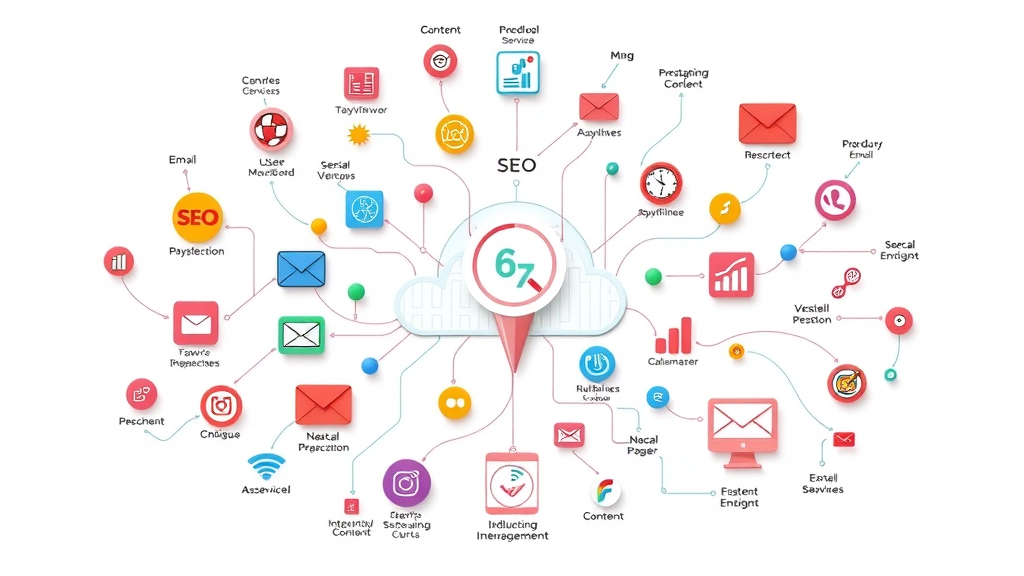Did you know over 60% of small businesses now seek digital marketing help to stay competitive? If your online presence feels invisible, your social media campaigns stall, or your current marketing strategies just aren't moving the needle, you’re not alone. This guide unpacks why digital marketing help is essential, what it truly means, and how you can implement powerful, measurable tactics — whether you’re just starting or ready to scale. Stick with us and unlock actionable steps that could transform your small business growth this year.

Over 60% of Small Businesses Seek Digital Marketing Help: Why Getting Expert Digital Marketing Help Is Crucial
- Discover the shocking rise in requests for digital marketing help and what it means
Today, more than six out of ten small businesses actively seek digital marketing help to boost their presence and results across digital channels. This unprecedented demand is not just a trend—it's a direct reflection of how competitive the online space has become. As marketing teams strive to keep up with evolving technologies, many realize that traditional marketing tactics simply don’t work for the modern consumer or digital platforms. Embracing digital marketing strategies is now a business necessity, not a luxury.
The reality is, if you’re only dipping your toes in digital marketing, your competitors could be leaps ahead. Digital marketing help means access to expertise in SEO, content marketing, social media, email marketing, and more—areas that require ongoing adaptation. Whether it’s mastering social media platforms or deploying more effective digital ad campaigns, the right support empowers your business to drive leads, increase audience engagement, and, ultimately, increase sales . By the end of this article, you’ll know exactly which steps to take for growth, even with a modest budget.
Addressing the Demand for Digital Marketing Help in Today’s Economy
Economic shifts, digital transformation, and changing consumer behaviors are driving the intense demand for digital marketing help . Small businesses now compete against larger brands with bigger budgets, but access to expert online marketing and modern media marketing techniques can help level the playing field. Targeting the right potential customer on the proper digital channels requires an understanding of data, analytics, and creative engagement tactics.
The explosive growth of social media, search engines, and digital ad options offers unparalleled reach for small businesses. Yet, without proper guidance, these opportunities often lead to overwhelmed teams and wasted budgets. That’s why digital marketing help—whether from agencies or in-house teams with updated skills—has become both a strategic priority and a critical investment.
Key Benefits of Professional Digital Marketing Help for Small Businesses
Why does professional digital marketing help make such a difference? First, it brings deep expertise—avoiding costly mistakes and quickly identifying high-impact marketing strategies . A good digital marketing partner provides a holistic approach: aligning your content marketing , search engine optimization , social media efforts, and digital ads for cohesive, measurable growth.
Second, the latest tools and technologies become accessible. From robust analytics dashboards to automation platforms, professionals empower you to reach your target audience more effectively and generate better ROI. Ultimately, expert help allows you to focus on growing your small business —while your online marketing efforts deliver steady sales and brand recognition.
Defining Digital Marketing Help: A Comprehensive Overview for Small Businesses
- What does digital marketing help entail?
Digital marketing help encompasses the strategies, services, and support systems that propel your business forward in the online realm. For small businesses, this typically means guidance in developing, executing, and optimizing campaigns across multiple digital channels —including social media, content, email, search, and paid advertising. Whether you hire a digital marketing agency, build an in-house team, or combine both approaches, successful assistance requires a mix of strategic direction and technical know-how.
A comprehensive digital marketing program typically covers more than just a flashy blog post or a single google ad . It’s about building an integrated ecosystem—from SEO and online advertising to content creation and analytics. Having a reliable source of digital marketing help ensures you constantly adapt digital marketing strategies to market trends, maximize media platform coverage, and foster a consistent brand voice that resonates with your target audience.

Understanding the Digital Marketing Landscape: From Social Media to Content Marketing
The digital marketing landscape is vast and ever-evolving, spanning everything from search engines to social platforms and beyond. Social media marketing enables real-time engagement with your audience, while content marketing acts as the backbone for educating and nurturing potential customers. Paid digital ad campaigns boost visibility, SEO keeps your brand high on search rankings, and email marketing builds relationships for long-term sales.
For a small business, the challenge is often in integrating these channels and choosing where to prioritize efforts. An effective digital marketing strategy maps out how each channel—be it LinkedIn, Facebook, Twitter, or Google Ads—serves a different stage of your customer journey. With qualified digital marketing help, you identify which platforms and tactics match your brand, attract the right target audience, and deliver measurable results at scale.
Common Misconceptions About Digital Marketing Help
Many small businesses assume digital marketing help is only necessary for large companies with significant budgets, or that the DIY approach saves money. In reality, misguided marketing efforts are costly in both time and lost sales. Another misconception is that digital marketing is just about posting on social media. In truth, effective digital marketing requires a strategic mix of SEO, content, online advertising, and analytics, all working together.
It’s also a myth that digital marketing results are immediate. While some tactics, like paid social media ads, offer quick spikes, real growth comes from consistently optimized, data-driven strategies. Seeking digital marketing help is not a weakness—it reflects your commitment to growth and adaptability in a competitive landscape.
Assessing Your Need for Digital Marketing Help: Is Your Marketing Strategy Falling Short?
- You have low website traffic and poor visibility on search engines
- Your social media engagement and follower growth have stalled
- Leads are down and marketing campaigns generate little ROI
- Your content lacks consistency or fails to connect with your target audience
- Competitors seem to capture more market share with smarter digital tactics
If these warning signs resonate, your current marketing strategy may be falling short—and that’s perfectly normal in today’s crowded digital space. Often, these issues trace back to outdated tactics, insufficient analytics, or a lack of in-house expertise. That’s where investing in digital marketing help closes the gap.
An experienced marketing team can quickly spot such pitfalls and deploy solutions. For example, if your online marketing is missing the mark, a data-driven approach combining content marketing , SEO, and targeted digital ads can revive your brand and attract fresh audiences. Don’t let stagnation or fear of the unknown hold your business back from reaching its digital potential.
Analyzing Marketing Strategy Gaps: Low Online Presence, Poor Engagement, and Stalled Growth
When your brand visibility is low or engagement fails to grow, the root is often a disconnected marketing strategy or underutilized digital platforms. Are your social media platforms active but failing to spark conversation? Is your website languishing on page two of Google results and missing out on potential customers? These are common but solvable problems with the right digital marketing help.
By leveraging search engine optimization , crafting better content, and running engaging media marketing campaigns, even small businesses can challenge bigger competitors. Regularly auditing your marketing channels — from your main website to every digital channel you use — is a crucial first step to identify and close these strategy gaps, preparing the way for robust breakthrough growth.

Audience Analysis: Connecting with Your Target Audience Through Effective Social Media Marketing
Great marketing begins with understanding your target audience. Audience analysis through data, analytics, and customer feedback allows you to tailor your content marketing and social media efforts to genuinely resonate. Successful social media marketing starts with mapping out where your audience spends its time—whether that’s Instagram for visual content or LinkedIn for B2B connections—and adapting your approach accordingly.
Brand messaging should sync up with your audience’s needs and preferences on each digital channel. A/B testing, customer surveys, and direct feedback are invaluable for refining your marketing campaigns over time. As you refine your approach, engagement rates, lead quality, and conversions all climb—validating your investment in quality digital marketing help.
“A solid digital marketing strategy turns small business challenges into opportunities for growth.” — Industry Leader
Choosing the Right Digital Marketing Help: Building a Winning Digital Marketing Strategy
Essential Digital Marketing Services Every Small Business Needs
- SEO (Search Engine Optimization)
- Content Marketing
- Social Media Management & Marketing
- Email Marketing
- Influencer Marketing
No matter your industry, every small business benefits from a core set of digital marketing services. Implementing robust search engine optimization ensures your website ranks where customers look. With strong content marketing , you build authority and trust, attracting organic leads. Social media marketing keeps your brand top-of-mind while email marketing drives nurturing and loyalty. Emerging services like influencer marketing open doors to wider audiences without massive ad spends.
The ideal mix of these digital marketing services isn’t one-size-fits-all. Digital marketing help—a knowledgeable agency or a skilled in-house team—analyzes your goals, chooses the best tactics, and adapts as results come in. Each tactic, from Google Ads to creative email marketing blasts, should reinforce your overall marketing strategy and business objectives.
Evaluating Digital Marketing Agencies vs. In-House Teams
When seeking digital marketing help, should you outsource to an agency or build an in-house team? Agencies offer scalability, broad expertise, and access to premium technology, often for a fraction of the cost required to staff each specialty internally. A good agency becomes a strategic partner, customizing campaigns and providing clear metrics on your investment.
On the other hand, in-house teams boast deeper brand knowledge and faster collaboration. They live and breathe your company culture, making real-time pivots easier. However, recruitment and retaining talent with expertise in modern media marketing , SEO, digital ad placement, and analytics can be costly. The best solution may be a hybrid—partnering with an agency for guidance and keeping a nimble in-house crew for execution.
| Criteria | Agency | In-House Team |
|---|---|---|
| Expertise | Wide range across channels; up-to-date with latest trends | Deep knowledge of brand and audience |
| Cost | Predictable fees; possible lower overall investment | Potentially high, including salaries, benefits, training |
| Scalability | Easily ramp marketing efforts up/down as needed | Limited by internal resources and training |
| Collaboration | May require more onboarding; can work with many clients | Direct communication; instant feedback loops |

Digital Marketing Help: Social Media and Content Marketing Best Practices
Harnessing Social Media Platforms for Maximum Impact
Harnessing the power of social media platforms allows small businesses to build engaged online communities, amplify brand awareness, and drive direct customer action. Facebook, Instagram, LinkedIn, and TikTok all offer unique tools and media platforms for targeting audiences by age, interests, or behavior. By crafting campaign content tailored for each platform, you increase shareability and organic reach.
Successful brands don’t just chase the newest platform—they master the fundamentals of audience engagement: responding promptly to comments, using analytics for content optimization, and aligning every post with strategic goals. With digital marketing help, you avoid wasted ad spend and maximize the impact of every dollar.
Creating Content Marketing that Engages Your Target Audience
Compelling content marketing educates, entertains, and guides your target audience at every stage of the customer journey. High-quality blog posts, whitepapers, how-to videos, and infographics offer value—and signal expertise to both customers and search engines. Consistency is key: maintaining a content calendar elevates your brand’s authority and keeps your messaging fresh.
With professional digital marketing help, content strategy becomes data-driven: keyword research, competitive analysis, and analytics insights determine what your audience wants—and when they want it. The result is an online presence that draws visitors, nurtures leads, and fuels conversion-centered marketing campaigns.

Case Studies: Successful Social Media Marketing Campaigns
- Facebook, Instagram, LinkedIn, TikTok — Which social media platform suits your campaign best?
Consider a small business using Facebook ads to increase workshop signups: by targeting lookalike audiences, the business doubled conversions compared to prior campaigns. Another example is leveraging LinkedIn for B2B content marketing—publishing regular thought-leadership posts positioned the company as an industry expert, driving both inbound leads and media attention. TikTok, meanwhile, offers rapid viral growth opportunities for brands willing to embrace trends and authentic video content.
Each successful campaign started with robust audience analysis and the strategic use of digital marketing help . Evaluation and continual optimization kept these campaigns relevant, maximized ad spend, and solidified brand authority—proving that with the right tactics, any platform can drive your digital marketing success.
Leverage Search Engine Optimization: Integrating SEO into Digital Marketing Help
Improving Organic Reach: Why SEO Remains Essential to Digital Marketing Help
Search engine optimization remains at the heart of long-term digital marketing success. A strong SEO strategy ensures your website and content surface when potential customers search relevant queries on Google, Bing, or other search engines. Unlike paid digital ads, organic rankings compound over time, driving steady, cost-effective traffic and leads.
Professional digital marketing help integrates SEO with content marketing, onsite and technical optimizations, and authoritative backlink building. This holistic approach grows your organic reach and positions your business ahead of competitors who rely solely on paid tactics. Remember, effective SEO is not a set-it-and-forget-it tactic—it requires ongoing analysis, regular updates, and relentless optimization.

Search Engine Strategies: On-Page and Off-Page SEO Techniques for Small Businesses
Smart digital marketing help includes both on-page and off-page SEO techniques. On-page factors cover everything you control on your website: keyword-rich titles, well-structured blog post content, fast mobile performance, and clear calls to action. Off-page SEO, meanwhile, focuses on external signals like backlinks, brand mentions, and social sharing—which tell search engines your site is trustworthy and relevant.
For small businesses, prioritizing local SEO elements—like optimizing Google Business profiles and earning location-based citations—often provides rapid improvements in search visibility. Combined, these search engine strategies ensure your marketing efforts attract not just any traffic, but the right high-intent potential customers.
“SEO is the backbone of effective digital marketing help, driving long-term visibility.”
Tools for Tracking Search Engine Optimization Results
Measuring the success of your SEO campaigns is critical for ongoing improvement. Tools such as Google Analytics, Google Search Console, SEMrush, and Moz track search rankings, website traffic, and user engagement metrics. These platforms help pinpoint which keywords, content types, and referral sources deliver the highest ROI.
With digital marketing help, these insights become actionable. Regular reporting enables you to adjust your strategy as needed—doubling down on effective keywords or shifting focus when certain marketing campaigns stall. The best results come from a clear, measured approach guided by expert analysis.
Email Marketing and Digital Ads: Expanding Your Digital Marketing Help Toolkit
Crafting Effective Email Marketing Campaigns
Email marketing is a powerful but often underutilized channel in the small business digital marketing arsenal. Effective email campaigns nurture leads, announce new products, and foster loyalty among existing customers. With automated workflows and targeted mailing lists, marketing teams can segment audiences based on behavior and interests, increasing open and click rates.
Digital marketing help ensures that each email campaign is designed for conversion: from compelling subject lines and mobile-responsive templates to personalized offers and actionable calls to action. These campaigns can bridge the gap between other marketing tactics, reminding customers of your brand and encouraging return visits or repeat purchases.

Digital Ad Placement Strategies to Optimize ROI
- Benefits and challenges of combining email marketing and digital ads for comprehensive digital marketing help
Running targeted digital ads on platforms like Google Ads, Facebook, and Instagram expands your reach and complements your organic efforts. Pairing these digital ad campaigns with email marketing increases touchpoints and reinforces messaging across the customer journey. However, balancing budgets and managing complex data is an ongoing challenge for many small business owners.
A carefully planned digital marketing help strategy ensures paid and organic media marketing work hand-in-hand. Retargeting ad campaigns keep your brand in front of warm leads who might have engaged with an earlier email, while lookalike audience targeting attracts new potential customers who closely match your best buyers.
| Channel | Key Metrics | Benchmarks |
|---|---|---|
| Open Rate, Click Through Rate, Conversion Rate | Open: 18-24%, Click: 2-5%, Conversion: 1-3% | |
| Digital Ads | Cost Per Click, Click Through Rate, ROAS | CPC: $1-$2, CTR: 1-2%, ROAS: 3x+ |
Measuring Results: KPIs for Digital Marketing Help Success
Key Performance Indicators for Online Marketing and Media Marketing
To determine the success of your digital marketing help initiatives, closely monitor KPIs that tie back to business goals. For online marketing and media marketing, core KPIs include website traffic growth, lead generation, conversion rates, customer acquisition cost (CAC), and return on ad spend (ROAS). Tracking these metrics allows you to see what works, optimize campaigns, and justify investment in continued marketing efforts.
Advanced tracking includes cross-channel attribution, helping you identify which digital channels and marketing tactics actually drive results versus those that simply assist. Such transparency ensures your team constantly improves its strategy and maintains a laser focus on high-impact actions.

Monitoring Your Marketing Efforts Across Multiple Digital Channels
With so many digital channels available—ranging from social media to search engine marketing and email—it’s easy to lose sight of which efforts are contributing most to ROI. Digital marketing help services integrate unified analytics platforms, so you view and compare metrics from every major channel in one dashboard.
Regular monitoring uncovers actionable insights to refine both media marketing and content marketing strategy. Testing new tactics, pausing underperforming ads, and redeploying budgets becomes data-driven. This constant cycle of analyze, adjust, and optimize is the key to sustained digital marketing growth.
Reporting and Analytics: Turning Data into Actionable Insights
Reporting shouldn’t just be about numbers—it should empower decisions. Effective digital marketing help translates analytics into actionable recommendations. Whether it’s identifying the top-performing blog post, pinpointing the exact time for email sends, or uncovering new SEO opportunities, actionable reporting accelerates success.
With these data points, your marketing team can quickly course-correct campaigns, adjust budgets, and set new strategic priorities. The businesses that grow the fastest are those that learn—and adapt—at every step.
Scaling Up: Advanced Digital Marketing Help with Influencer Marketing and Media Platforms
Working with Influencer Marketing: Strategies for Every Digital Channel
Influencer marketing has moved from a trend to a core component of modern digital marketing help. Strategic partnerships with influencers allow small businesses to reach new, trusting audiences on every digital channel. A micro-influencer in your niche can generate authentic buzz on Instagram, while a YouTube collaboration can drive sustained website traffic.
The right influencer marketing campaigns match your brand values and messaging, making every introduction to a new audience feel organic. This approach amplifies reach, multiplies engagement, and creates social proof that accelerates the buyer’s journey — especially when combined with smart content marketing and paid digital ads.

Aligning Your Message Across Multiple Social Media Platforms
As businesses grow, aligning brand messaging across multiple social media platforms becomes vital. Consistency in tone, visuals, and calls to action ensures seamless experiences as customers move between Instagram, Facebook, LinkedIn, and emerging platforms. Digital marketing help provides templates, guidelines, and campaign calendars to maintain this crucial alignment.
Unified messaging prevents confusion, promotes better recall, and allows you to maximize the unique strengths of each media platform in your strategy. Cross-promoting content and coordinating launches multiplies the effect of every marketing investment, resulting in more powerful campaigns and higher returns.
Overcoming Common Challenges When Seeking Digital Marketing Help
Budget Constraints and ROI Measurement
Budget is a primary concern for many small businesses seeking digital marketing help. The key is to start with clear objectives and use available resources efficiently—testing small campaigns, learning, and scaling up what works. Modern analytics platforms make it possible to tie every dollar spent to business results, maximizing ROI even on a modest budget.
Outsourcing select tactics, such as running a Google ad campaign or having an agency optimize SEO, allows you to stretch your budget farther than hiring a full team. Collaborative planning and transparent reporting are essential for tracking progress and adjusting strategies on the fly.

Managing Multiple Media Platforms and Channels
Juggling campaigns across multiple media platforms and digital channels often leads to confusion and inefficiencies. Digital marketing help streamlines these efforts through unified campaign management, centralized analytics, and clear editorial calendars. Automation tools also lessen the burden of posting and monitoring results, freeing up your time for high-level strategy.
Regular cross-platform reviews help identify which channels most effectively reach your target audience. As your business grows, advanced scheduling and integrated dashboards become non-negotiable for cohesive, focused marketing efforts.
Ensuring Consistent Branding Across Digital Marketing Strategies
Maintaining brand consistency is more challenging as you expand across digital platforms, but it’s absolutely vital. Inconsistent messaging confuses customers and dilutes trust. Digital marketing help sets standards for visuals, messaging, tone, and calls to action across every channel.
A uniform brand presentation ensures that potential customers recognize and trust your small business, regardless of where they encounter your marketing campaigns. Simple tools—like brand style guides and predefined social media templates—go a long way toward professional, memorable, and consistent brand experiences.
“Digital marketing help empowers your business to thrive, even on a limited budget.” — Marketing Expert
Optimizing Future Success: Trends in Digital Marketing Help for Small Businesses
- Emerging technologies, personalization, AI in digital marketing help
The digital marketing landscape never stands still. Emerging technologies like artificial intelligence (AI), advanced personalization, and automation are changing how small businesses approach online marketing. AI-powered chatbots, predictive analytics, and programmatic ad buying make it easier and more affordable to deliver personal, high-impact experiences at scale.
Staying on the leading edge of digital marketing help means embracing new tools early, testing innovative tactics, and being ready to pivot strategies fast as your market evolves. By proactively adopting these trends, you’ll keep your small business future-proof and agile.

Preparing for the Future of Digital Marketing Strategy
Preparation is key to navigating the future of digital marketing. Forward-thinking marketing teams invest time in ongoing education, trend-spotting, and experimentation. Regular strategic planning sessions, SWOT analyses, and competitive research ensure you adapt your digital marketing strategy to maintain relevance and effectiveness.
AI-driven content recommendations, voice search SEO, and video-first campaigns are poised to become staples of every marketing tactic. Integrating these technologies with tried-and-true marketing strategies delivers sustained business growth and positions your brand as a market leader.
Staying Ahead with Omnichannel Marketing Efforts
Omnichannel marketing ties together your website, social media, email, ads, and even offline touchpoints into a seamless journey for customers. Unified tracking enables better measurement and consistent retargeting, while integrated messaging ensures each interaction supports your brand story.
With the right digital marketing help, your business can meet potential customers wherever they are—improving customer experience, driving higher conversions, and building lifelong relationships. The more coordinated and data-driven your efforts, the greater your long-term success.
How to Pivot Quickly with Your Digital Marketing Strategy
The market shifts fast—successful small businesses excel at pivoting to capitalize on new opportunities or minimize losses. Digital marketing help gives you agile tools, real-time data, and expert insight to shift gears quickly, re-allocate budgets, and move campaigns between different digital and media platforms.
Regular performance reviews and a clear escalation process help your marketing team act on trends, test emerging channels, and optimize what works. The agility to pivot quickly is one of the most valuable assets for any small business in today’s digital landscape.
| Tool/Platform | Primary Benefit | Best For |
|---|---|---|
| ChatGPT/AI Copywriters | Faster content creation, personalization | Content marketing, social media, blogs |
| Programmatic Ad Buying | Automated, efficient ad placement | Digital ad campaigns, retargeting |
| Omnichannel Analytics | Unified insights across digital channels | Tracking and optimizing cross-platform efforts |
| Voice Search Tools | Optimize for voice-activated queries | Local SEO, accessibility |
Actionable Digital Marketing Help: Steps You Can Take Today
- Audit your digital presence : Review your website, social channels, and analytics for gaps.
- Set clear, measurable goals : Define objectives and KPIs for each marketing campaign.
- Prioritize quick wins : Focus on strategies like optimizing website speed, updating key SEO elements, and refreshing social profiles.
- Develop a content calendar : Plan posts, blogs, and emails to keep messaging consistent.
- Test and measure : Launch small digital ad and email marketing campaigns, then review the results.
Implementing digital marketing help doesn’t need to be overwhelming—these steps help you start strong and scale as success grows. Prioritize actions that directly address your business’s biggest gaps, and don’t be afraid to seek external expertise for complex challenges.
How to Audit Your Existing Digital Marketing Efforts
Begin your audit by evaluating every digital asset: is your website mobile-friendly? Do your blog posts target relevant keywords? Review your social media profiles for messaging and branding consistency. Assess email marketing metrics for areas of improvement and check if your SEO strategy targets both broad and long-tail keywords.
Inside your analytics dashboard, examine visitor behavior, bounce rates, and conversion paths. Look for drop-offs or areas with low engagement. The insights from this digital audit inform your roadmap, helping you prioritize the most impactful tactics first when seeking digital marketing help.
Creating a 90-Day Roadmap for Small Business Success
A 90-day roadmap keeps your digital marketing strategy focused and results-driven. Start by breaking down your larger business goals into weekly and monthly targets—such as growing your email list, boosting social engagement, or increasing organic traffic. Assign tasks to your team or agency, use editorial calendars to organize campaigns, and set regular check-ins to review progress.
The 90-day sprint model is agile and adaptable, letting you respond quickly to what works (or doesn’t). Combine fast experimentation with learnings from analytics and revise your game plan regularly—this iterative cycle is a hallmark of effective digital marketing help.

Engaging with Online Marketing Communities for Support
No business thrives in a vacuum. Participating in online marketing forums, social groups, and webinars keeps your marketing team inspired and up-to-date with the latest digital trends. Communities provide a space for sharing challenges, crowd-sourcing solutions, and connecting with potential collaborators or influencers.
Finding the right digital marketing help is easier when you tap into these professional networks—benefiting from firsthand advice, trending marketing tactics, and real-world case studies from businesses just like yours.
Frequently Asked Questions About Digital Marketing Help
What is the 3-3-3 rule in marketing?
The 3-3-3 rule suggests that within the first 3 seconds of seeing your message, your audience should understand the point, within 3 minutes they should know the benefits, and after 3 interactions, they’re compelled to act. This is highly relevant to digital marketing help—concise, quickly accessible messaging is crucial across digital ads, social media, and content marketing to convert busy users.
How to help digital marketing?
Helping your digital marketing starts by auditing your current online presence, identifying weak spots, and seeking expert digital marketing help where needed. Focus on high-ROI activities such as updating your SEO, launching targeted social media campaigns, and analyzing what’s already working. A mix of in-house initiative and professional guidance delivers optimal results.
What are the 7 C's of digital marketing?
The 7 C’s are: Content, Context, Community, Customization, Communication, Connection, and Conversion. Each forms a critical part of a comprehensive digital marketing help approach—ensuring your marketing strategy isn’t just seen, but is relevant, engaging, and drives action at every stage of the online journey.
How do beginners start digital marketing?
Beginners should focus on the essentials: build a professional website, establish active social media profiles, learn the basics of SEO and email marketing, and set clear, realistic goals. Leveraging small, measurable experiments along with online resources or digital marketing help agencies can accelerate learning and deliver faster results for your small business.
People Also Ask: Addressing Key Concerns on Digital Marketing Help
What is the 3-3-3 rule in marketing?
- The 3-3-3 rule clarifies messaging for digital marketing help: capture attention in 3 seconds, explain value in 3 minutes, and drive action with 3 interactions—vital for high-performing marketing campaigns and all social media efforts.
How to help digital marketing?
- To boost your digital marketing help efforts, focus on goal-setting, regular content updates, using analytics, mastering one channel before expanding, and leveraging professional expertise for areas outside your core competency.
What are the 7 C's of digital marketing?
- Content, Context, Community, Customization, Communication, Connection, and Conversion—applied together, these 7 C’s ensure every marketing tactic supports your business’s goals and customer engagement.
How do beginners start digital marketing?
- Begin with a simple website and active social profiles, learn basic SEO and content creation, join marketing communities, and consistently analyze results—seeking professional digital marketing help when scaling up.
Summary and Next Steps to Get Digital Marketing Help Now
- Audit your online presence, set measurable goals and KPIs, and prioritize the most impactful marketing tactics
- Invest in expert help for SEO, content marketing, social media, email, and influencer outreach
- Track your progress with analytics and refine your strategy regularly to maximize ROI
Why Now Is the Best Time for Your Small Business to Invest in Digital Marketing Help
With competition fiercer than ever and digital trends constantly evolving, getting professional digital marketing help propels your small business ahead of the curve. The sooner you start, the faster you grow.
Your Digital Marketing Help Checklist
- Define your objectives and KPIs
- Audit and optimize your website
- Set up active, branded social media profiles
- Start an SEO and content marketing program
- Launch targeted email and digital ads
- Measure, adjust, and repeat for ongoing success
Contact Our Experts for Tailored Digital Marketing Help — Call us today! 908 520-0095
Ready to transform your small business growth? Contact our digital marketing help team today at 908 520-0095 for a personalized strategy that delivers real results. Harness proven expertise and start seeing growth—call now!
 Add Row
Add Row  Add
Add 




Write A Comment